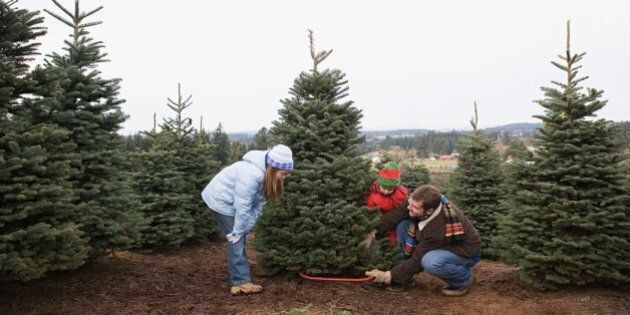
At this point, the annual debate over buying a real or fake tree is older than the Charlie Brown Christmas special.
People who like real trees talk of tradition, the great smell and cherished memories of chopping down a pine with their old man, while proponents of artificial trees rave over the convenience and lack of mess.
Yes, it's a good-natured argument for sure, but only one choice is actually good for nature itself. As the president of Tree Canada, an organization that's helped plant more than 80 million trees over the past 20 years, you might expect an argument against cutting down a "live tree," but make no mistake -- you are helping both the environment and the community you live in when you choose a real tree.
Where trees come from
Canadians spend approximately $56 million each year on artificial trees produced in factories in China, Taiwan and South Korea, where less stringent environmental regulations, poorer working conditions and lower wages often prevail.
On the other hand, real Christmas trees are produced from sunlight, rainfall and good soils, period. Planted much like an agricultural crop, these trees provide wildlife habitat as they grow until they are harvested and replaced by another tree. In addition, real Christmas trees are grown on family farms, representing more than $100 million to the rural Canadian economy.
Where trees end up
On average, artificial trees last seven to 10 years and cannot be recycled, so they must be land filled or incinerated. In landfills, the non-biodegradable materials take an extremely long period to break down while incineration can cause plastics, such as PVC, to release dioxins and other carcinogens into the air.
Now, back to a fresh cut Christmas tree -- which, of course, is recyclable and biodegradable. Once used, the tree can be chipped for mulch, burned, or land filled, where it will naturally break down over time; if used for firewood, a real tree will release a relatively small amount of carbon dioxide into the atmosphere.
Impact on the environment
Artificial trees pose a real hazard to the environment, to workers and to Canadian consumers. These fake trees are composed mostly of polyvinyl chloride (PVC), a non-renewable and potentially polluting petroleum product. In addition, large amounts of fossil fuels are required to transport the plastic trees (usually from Asia), adding more greenhouse gases to the atmosphere.
PVC also contains Phthalates, which have been shown to accumulate in body tissues and are linked to damage in the liver, lungs and reproductive organs in mammals. Lead, a cumulative toxin, is often used in the production of PVC and can also lead to environmental and health-related problems including nervous system damage, particularly in children.
Conversely, there are numerous environmental benefits created through the growth of natural Christmas trees. Besides providing wildlife habitat, the trees stabilize and protect soil, watercourses and help moderate floods and droughts. They also act as air filters and produce clean oxygen for all breathing creatures -- for instance, every acre of growing Christmas trees provides the necessary daily amount of oxygen for 18 people.
Depending on where you live in Canada, some fossil fuel pollution is likely generated in the transport of real Christmas trees, but this is offset by the fact that trees capture many harmful greenhouse (and other) gases during their growth period. And, while fertilizers are sometimes used to boost a tree's growth and colour and/or to guard against weeds or insects, neither pose a health threat to workers or consumers when done correctly.
When you add it all up, the only true health concern from a real Christmas tree comes from those unfortunate enough to suffer from allergies. Otherwise, fresh cut trees are environmentally friendly and offer incredible benefits to both our community and the Canadian economy.
While the debate over real v. fake trees will never end, I hope you and your family make the smart choice this holiday season.
MORE ON HUFFPOST:
